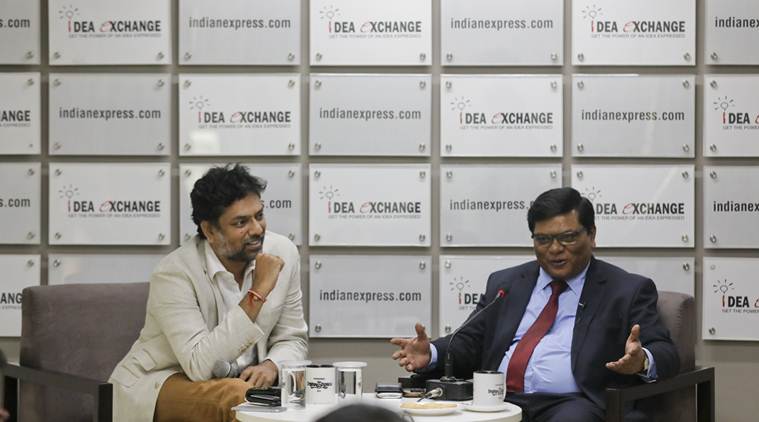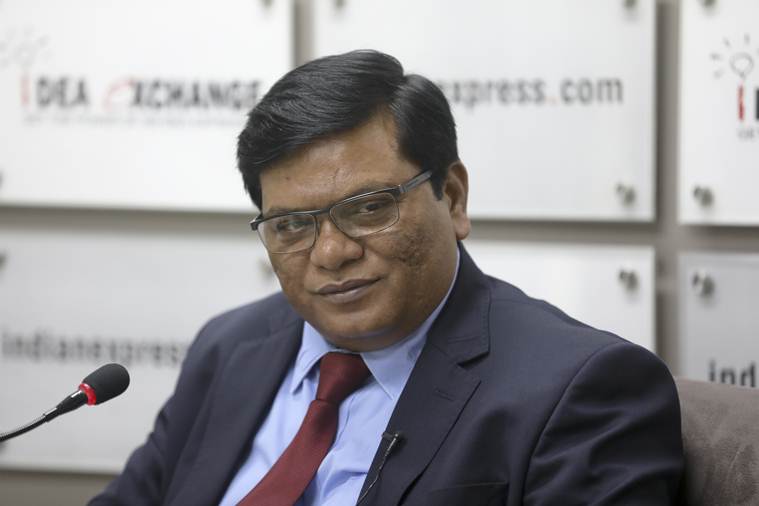By: Express News Service | Updated: September 30, 2018 6:53:34 am
Milind Kamble, Chairman of the Dalit Indian Chamber of Commerce and Industry, says the word ‘Dalit’ provides “emotional connect”, asserts that 4 % procurement law ensures Dalit inclusion, says private sector affirmative action agenda has been “derailed a bit” and urges govt to “push harder” to meet Stand Up India targets.
Why Milind Kamble?
Protests, calls for shutdowns, and a growing demand for reservation in jobs and promotions — the Dalit voice in the country has never been louder. Kamble, who founded the Dalit Indian Chamber of Commerce and Industry in 2005 and is now its chairman, says that both the government and the industry have to stick to their commitments to fulfil the aspirations of the community and to ensure an equitable society. Under Kamble, DICCI has been at the forefront of government schemes such as Stand Up India, besides aiding several Dalit MSMEs and businesses.
P VAIDYANATHAN IYER: Originally, the Dalit Indian Chamber of Commerce and Industry (DICCI) was called the Scheduled Caste Entrepreneurs Forum. Now the government has asked states and the media to ‘refrain from using the nomenclature Dalit’ and, instead, use only the Constitutional term, ‘Scheduled Caste’. What does ‘Dalit’ mean to you?
In India, every state has people belonging to Scheduled Castes and Scheduled Tribes. Particularly, SCs. People from the North, South, East and West connect emotionally through the word Dalit. It gives them an identity. The perception in society is that people from the SC/ST communities are seekers. But in our Chamber, there are several people running corporate houses, providing jobs… The people of India must know that Dalits are also present in the corporate world.
The government’s advisory (on nomenclature) is based on the court’s decision. That’s okay, they are doing their job. But DICCI is now a worldwide brand and we will not drop the word Dalit from its name.
P VAIDYANATHAN IYER: One of the most common problems that entrepreneurs in general, and Dalit entrepreneurs in particular, face is access to funds. You have often said that we need to move away from collateral lending. More so because Dalit entrepreneurs cannot provide collateral. What is DICCI doing to ensure that?
Jobs in the government sector are shrinking. For Dalit start-ups, it is very difficult to get early-stage funding. In India, our lending system is collateral-based. We spoke to the government about policy and equity support through banks. SC/ST youth want to start enterprises and so support needs to be created to promote entrepreneurship in the community. These talks have been going on for long. In 2015, the government instituted the MUDRA scheme and the Stand Up India scheme, which were collateral-free, and people got funds. Now, we have also created venture capital funds and many such schemes.
P VAIDYANATHAN IYER: For the past many years, there have been efforts to ensure 4 per cent government procurement from SC/ST entrepreneurs. But so far, the procurement has been very less — between 0.5 and 1 per cent. Why is this the case?
SME (small and medium enterprises) is the growth engine of the Indian economy, but it faces many challenges. One is access to equity and capital markets. Second, acquisition and retention of talent. However, Indian SMEs are growing despite that. If we had one crore SMEs in 2001, today we have about six crore. We have to create a support system for them.
The Micro, Small and Medium Enterprises Development (MSMED) Act was modified in 2012 to ensure a market for Indian SMEs within the government. The government is the biggest buyer. It has more than 250 CPSUs (Central Public Sector Undertakings), nearly 60-65 departments, plus the ministries. Through these, the government makes purchases worth Rs 6 lakh crore. To create an assured market, the government has decided to set aside 20 per cent of this procurement for Indian SMEs. In 2012, the then MSME Minister, Virbhadra Singh, moved the Bill for this. We (DICCI) intervened then and said that of the 20 per cent procurement, 4 per cent must be set aside for SC/ST SMEs. The government considered the proposal and eventually 4 per cent procurement was set aside.
For three years, it was voluntary procurement but it was not enough. In 2015, under the new government, we renewed our push and said that the 4 per cent procurement must be made mandatory. From April 1, 2015, the policy became mandatory. We also pushed for the introduction of a mechanism similar to the US. The industry and government there are very pro-active. There is affirmative action. They have created a joint mechanism with industry and government stakeholders and it is referred to as the National Minority Supplier Development Council. It is a bridge between government procurement agencies, private procurement agencies and minority entrepreneurs. We need a similar mechanism and we pushed for it. The PMO invited us and we gave a presentation. We also sought a national SC/ST hub in the MSME Ministry; Rs 490 crore was allocated for it in the 2016 Budget. Last year, procurement stood at Rs 550 crore. It does not meet the target but there has been an increase.
The government has also created a portal called MSME Sambandh, which has 165 CPSUs registered on it. They have to mention their annual procurement plan on the portal and the list of the items procured. This has helped.
P VAIDYANATHAN: But if 4 per cent procurement is mandatory, why don’t PSUs, departments and ministries meet their annual targets? A handful of companies are responsible for the bulk of the procurement from SC/ST entrepreneurs.
The Secretary of the Ministry of MSME frequently meets the Secretary of the Department of Public Enterprises. There are also interactions between other secretaries regarding this. They are all trying to push for it. The CPSUs have to come out with annual reports. In that report they have to specify what they have done about the 4 per cent rule. So things are moving.
SUNIL JAIN: Every SME entrepreneur says that doing business in India is very tough. So what do you think is more important for an SC/ST entrepreneur —to have the government liberalise the business environment for everyone or ensure reservation?
Due to open market and free economy, our size (Dalit entrepreneurs) is increasing. SC/ST youth also want to own enterprises. That is why we asked the government to set aside a small percentage (in procurement) for them. There is no compromise on the quality or cost. It was for creating an assured market to give confidence to the people.
Yes, it is very difficult to enter the Indian market. Nandan Nilekani was born in an upper-caste family. His friends and family were also from the community. He studied at IIT Powai. But despite these privileges, he wrote in his book how difficult it was for a new entrepreneur to enter the market. If he faced such issues, then think about the problems of a Dalit youth. So by setting aside 4 per cent procurement, the government is providing them a launch pad. Only 4 per cent has been set aside, 96 per cent of the market is for others. The government has to work for everyone. If there are no jobs here, there has to be an alternative and that is what we have created.
SHOBHANA SUBRAMANIAN: There are millions of Indians who come from very poor families and cannot access organised financing. Why should SC/ST youth be given preference?
It is for social and financial inclusion. SC/ST youth don’t have much assets to mortgage with the bank, to give as collateral. They face difficulties getting access to capital. So the government has created a few relaxations. It is for the creation of an equitable society.
SHOBHANA SUBRAMANIAN: Is this facility available to second-generation SC/ST entrepreneurs?
This question is related to reservation. I am very clear that all reservation should be applicable only up to three generations. After that, they will be empowered.
P VAIDYANATHAN IYER: While private companies often talk about affirmative action, it has been more of a lip service so far.
The government had said that for social and financial inclusion, the private sector will have to take some responsibility. There is a lot of debate about it. The Dalit leadership had also demanded that there should be reservation in the private sector. Mainstream chambers such as CII, ASSOCHAM and FICCI made a code of conduct and every company committed to affirmative action.
Indian society is caste-based and, because of that, there are a lot of market biases as well. It is the right time to assess what the Indian industry has done on affirmative action… As a member of the CII on affirmative action, along with other companies, I am a bit disappointed. The agenda has been derailed a little bit.
In 2013, people started thinking that CSR (Corporate Social Responsibility) is affirmative action. They failed to differentiate between philanthropy and commitment. These are two different things. Everyone is doing it through taxes and employment generation, but we have to walk the extra mile for an inclusive society. From top to bottom, the actual procurement base has to be sensitised. By setting aside a percentage of its procurement, the government has taken a step forward. Now the Indian industry needs to do it too.
ANIL SASI: Among the states, there is a sense that Telangana and Tamil Nadu are doing a lot to promote Dalit entrepreneurs.
Yes, in Telangana and Andhra Pradesh, the government has proactively supported the creation of an ecosystem to promote entrepreneurship. Their policies are a model for other states. In Tamil Nadu too, the government is very proactive. In Andhra Pradesh, Telangana, Tamil Nadu, Karnataka and Kerala, we have partnered with the governments to promote SC/ST entrepreneurship. Maharashtra also has a good policy. Gujarat has the best policy because they have considered several factors such as rental premises, mentoring support… There is a policy in all states but its execution and support are better in Telangana and Andhra.
DEVYANI ONIAL: You say caste can be fought with capital. But despite having financial agency, a Dalit still gets killed for marrying an upper caste.
That is a fact. There are a few people in the SC community who are economically empowered. A large section of the population continues to live in villages and they face discrimination on a daily basis. I am not saying that discrimination has ended due to globalisation but this (capital) is one way to overcome the bias. Who goes through atrocities? The poor. It does not happen to those who are economically empowered. Economic empowerment is very important for the SC/ST community and capital is the best way to fight caste.
The market is not concerned about who is making the product. If the quality and the cost are good, they will buy it. This is the greatness of a market economy — anyone can make a product and anyone can sell. Babasaheb Ambedkar also urged Dalits to leave villages and come to cities. In the city, there is opportunity, modernisation, industrialisation. In the village, people know me as ‘Kamble’. It is difficult to be successful in such a system. In the city, it is possible. If the caste system has to be broken, capital will break it.
RAVISH TIWARI: Over the years, do you see the rural caste hierarchy replicating itself in urban areas?
Mindsets are changing. Social reform is a very slow process but a beginning has been made. I am hopeful. The Indian industry has responded positively. The situation in cities is not the same as in the villages.
ANIL SASI: A few months ago, you said that the NDA government has been better than the UPA on affirmative action. What made you say that?
We had made several pitches to the previous government. They had come up with the ( 4 per cent) procurement policy in 2012-13. In 2014, the present government took charge and we made pitches to them as well. So far, whatever we have said, the government has considered. It’s a fact.
AMRITH LAL: The 2002 Bhopal Declaration was aimed at addressing issues concerning economically and socially deprived Dalit and tribal communities of Madhya Pradesh. What impact did it have on the ground?
Following the declaration, the MP government drafted a policy to ensure 30 per cent of its procurement is from SC/ST people. But there were a lot of problems, like the clause which stated that the supplier needed to be a manufacturer. It was the main hurdle. So it didn’t have much impact and eventually the policy was scrapped.
SHYAMLAL YADAV: You said that the Stand Up India scheme has been slow.
The scheme came from my suggestion to the government. We said that we have 27 public sector banks which have 1.25 lakh branches, and that on the occasion of Babasaheb’s 125th birth anniversary, we should have 1.25 lakh new entrepreneurs. It became a scheme and women from the general category were also added to it. Every bank branch was given a target of supporting two people. So far, 65,000 people have got loans under the scheme, of which 20,000 are from the SC/ST community and 45,000 are upper-caste women. To meet the 1.25 lakh target, the government needs to push harder.
RAJ KAMAL JHA: What is DICCI’s stand on reservation in the private sector?
DICCI’s official stand is that there should be reservation. In Dalit communities, economic empowerment has happened very fast and is continuing because of the liberal economy. There is research on this. I feel that market and money will defeat Marx and Manu because both are against capital. Manu says Dalits should not hoard capital and the Marx theory is anti-capital. But the market is growing, shouldn’t Dalits be moving with it too?
Source: https://indianexpress.com/article/india/capital-can-break-caste-system-market-and-money-will-defeat-anti-capital-marx-and-manu-milind-kamble-5379652/


 Milind Kamble said, “The government has to work for everyone. If there are no jobs here, there has to be an alternative and that is what we have created.” (Express photo by Abhinav Saha)
Milind Kamble said, “The government has to work for everyone. If there are no jobs here, there has to be an alternative and that is what we have created.” (Express photo by Abhinav Saha)